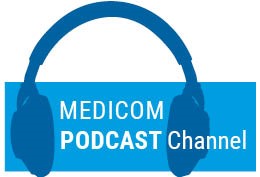The rationale behind this study stems from the fact that most B-NHL patients relapse or become refractory (R/R) to CD20-specific monoclonal antibodies, but CD3xCD20 bispecific antibodies have shown promising results and may ameliorate resistance. The current poster presented dose-escalation data from the ongoing trial testing epcoritamab, a novel, subcutaneously administered CD3xCD20 agent. The primary endpoints were to determine the maximum tolerated dose (MTD) and recommended phase 2 dose (RP2D). A key secondary objective was to analyse initial anti-tumour efficacy.
At the time of data cut-off, 41 R/R CD20+ B-NHL patients (median age of 66), all treated with prior anti-CD20 therapy potentially in combination with chemotherapy and/or relapsed after autologous stem cell rescue, received a single subcutaneous injection of flat-dose epcoritamab in 28-day cycles (every 1 week: cycle 1–2; every 2 weeks: cycle 3–6; every 4 weeks thereafter) until disease progression or unacceptable toxicity. Risk mitigation for cytokine release syndrome included use of corticosteroids and priming and/or intermediate doses of epcoritamab.
With a median follow-up of 4.7 months, no dose-limiting toxicities were observed and MTD was not reached. The most common (>35%) treatment-emergent adverse events (TEAEs) were pyrexia (71%), fatigue (46%), and injection site skin reaction (39%). Cytokine release syndrome was determined by laboratory in 59% patients, but all was grade 1/2 and self-resolved. There were no treatment-related deaths.
Preliminary anti-tumour activity at doses above the 0.76 mg cut-off indicated dose-dependent efficacy and includes complete responses (see Table). These responses appear to be effective and potentially durable as all patients achieving complete response remain in remission.
Table. Anti-tumour activity in R/R B-NHL [1]

Efficacy data are based on snapshots taken on February 11, 2020.
B-NHL, B-cell non-Hodgkin lymphoma; CR, complete response; DLBCL, diffuse large B-cell lymphoma; FL, follicular lymphoma; HGBCL, high-grade B-cell lymphoma; ORR, overall response rate; PD, progressive disease; PR, partial response; R/R, relapsed or refractory; SD, stable disease.
In conclusion, subcutaneous epcoritamab had a favourable safety profile across all doses, with no severe or life-threatening events, and no dose-limiting toxicities. Dose-escalation data indicate dose-dependent efficacy, even inducing complete responses in patients with diffuse large B-cell lymphoma/HGBCL. Additional research is warranted; industry and investigators will proceed with phase 2 investigation.
- Hutchings M, et al. Subcutaneous epcoritamab (gen3013; cd3xcd20) in patients with relapsed/refractory B-cell non-Hodgkin lymphoma: dose-escalation data from a phase 1/2 trial. EHA25 Virtual, 11-21 June 2020, Abstract EP1218.
Posted on
Previous Article
« Two trials: acalabrutinib in CLL Next Article
Pembrolizumab improves PFS for relapsed/refractory Hodgkin lymphoma »
« Two trials: acalabrutinib in CLL Next Article
Pembrolizumab improves PFS for relapsed/refractory Hodgkin lymphoma »
Table of Contents: EHA 2020
Featured articles
Myeloid
VIALE-A: newly diagnosed chemo-ineligible AML
DEC10-VEN superior to intensive chemotherapy in high-risk AML
Magrolimab plus azacitidine: good ORR in MDS/AML
Asciminib monotherapy in Ph+ CML: major molecular responses
CML TKI interruption: Swedish registry results
Patients with lower-risk MDS benefit from imetelstat
Better outcomes adding enasidenib to azacitidine in mIDH2-AML
Lymphoid
PET-stratification can omit radiotherapy in early-stage unfavourable Hodgkin lymphoma
Pembrolizumab improves PFS for relapsed/refractory Hodgkin lymphoma
Promising first-in-human trial of epcoritamab in B-NHL
Two trials: acalabrutinib in CLL
Zanubrutinib versus ibrutinib in Waldenström macroglobulinaemia
Deep responses in R/R CLL with venetoclax monotherapy
MRD assessment post-CAR-T predicts ALL allo-HSCT bridging
Plasma Cell Dyscrasias
Daratumumab for light-chain amyloidosis
Isatuximab triplet improves PFS in R/R MM
Initial results from CAR-T cell therapy in MM: KarMMa
Graft-Versus-Host Disease
GRAVITAS-301: improved complete aGVDH response
Ruxolitinib improves steroid-refractory aGVHD across subtypes
Benign Haematology
Paroxysmal nocturnal haemoglobinuria treatment with pegcetacoplan
Mitapivat, a pyruvate kinase-R activator, in SCD is safe with early efficacy results
SCD LentiGlobin gene therapy: new data on VOC and ACS
Paediatric Haematology
Venetoclax + navitoclax promising for R/R ALL or LL
Nivolumab/brentuximab vedotin in R/R HL: good CMR rates
Bench-to-Bedside Science from the Presidential Symposium
Microbiome predicts B-ALL predisposition
Netrin-1 regulates haematopoietic stem cells
Unrecognised role of iron in neutrophil differentiation
Related Articles
August 28, 2020
Venetoclax + navitoclax promising for R/R ALL or LL
September 9, 2020
Two trials: acalabrutinib in CLL

September 9, 2020
EHA25 Highlights Podcast
© 2024 Medicom Medical Publishers. All rights reserved. Terms and Conditions | Privacy Policy
HEAD OFFICE
Laarderhoogtweg 25
1101 EB Amsterdam
The Netherlands
T: +31 85 4012 560
E: publishers@medicom-publishers.com

